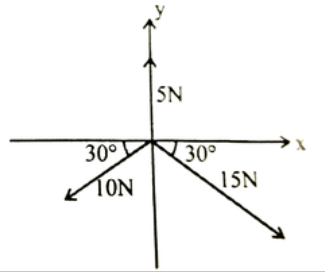If the resultant of the two forces has a magnitude smalle than the magnitude of larger force,the two forces must be
(a)Different both in magnitude and direction
(b)Mutually perpendicular to one another
(c)Possess extremely small magnitude
(d)Point in opposite directions
The correct Answer is:D
To solve the problem, we need to analyze the conditions under which the resultant of two forces is smaller than the magnitude of the larger force.
1. Define the Forces:
Let F be the larger force and f be the smaller force. We assume F>f.
2. Understanding Resultant Force:
The resultant force R of two forces F and f can be calculated using the law of cosines. The formula for the magnitude of the resultant R when two forces are at an angle θ is given by:
R=√F2+f2+2Ffcos(θ)
3. Condition Given:
We are given that the resultant R is smaller than the larger force F:
R<F
4. Setting Up the Inequality:
Squaring both sides of the inequality gives:
R2<F2
Substituting the expression for R:
F2+f2+2Ffcos(θ)<F2
5. Simplifying the Inequality:
By subtracting F2 from both sides, we have:
f2+2Ffcos(θ)<0
6. Analyzing the Inequality:
For the left side f2+2Ffcos(θ)<0 to hold true, the term 2Ffcos(θ) must be negative enough to make the entire expression less than zero. This implies:
cos(θ)<−f22Ff=−f2F
Since F>f, this indicates that cos(θ) must be negative, which occurs when the angle θ is between 90∘ and 270∘.
7. Conclusion:
The only way for the resultant R to be smaller than the larger force F is if the two forces are acting in opposite directions. Therefore, the two forces must be pointing in opposite directions.
Final Answer:
The two forces must be pointing in opposite directions.
Let F be the larger force and f be the smaller force. We assume F>f.
The resultant force R of two forces F and f can be calculated using the law of cosines. The formula for the magnitude of the resultant R when two forces are at an angle θ is given by:
R=√F2+f2+2Ffcos(θ)
We are given that the resultant R is smaller than the larger force F:
R<F
Squaring both sides of the inequality gives:
R2<F2
Substituting the expression for R:
F2+f2+2Ffcos(θ)<F2
By subtracting F2 from both sides, we have:
f2+2Ffcos(θ)<0
For the left side f2+2Ffcos(θ)<0 to hold true, the term 2Ffcos(θ) must be negative enough to make the entire expression less than zero. This implies:
cos(θ)<−f22Ff=−f2F
Since F>f, this indicates that cos(θ) must be negative, which occurs when the angle θ is between 90∘ and 270∘.
The only way for the resultant R to be smaller than the larger force F is if the two forces are acting in opposite directions. Therefore, the two forces must be pointing in opposite directions.
The two forces must be pointing in opposite directions.
Topper's Solved these Questions
- BASIC MATHEMATICS & VECTORSBOOK - VMC MODULES ENGLISHCHAPTER - BASIC MATHEMATICS & VECTORSEXERCISE - Efficient
50 Videos
- BASIC MATHEMATICS & VECTORSBOOK - VMC MODULES ENGLISHCHAPTER - BASIC MATHEMATICS & VECTORSEXERCISE - Impeccable
50 Videos
- BASIC MATHEMATICS & VECTORSBOOK - VMC MODULES ENGLISHCHAPTER - BASIC MATHEMATICS & VECTORSEXERCISE - Impeccable
50 Videos
- CAPACITORSBOOK - VMC MODULES ENGLISHCHAPTER - CAPACITORSEXERCISE - JEE Advance ( Archive ) LEVEL 48
1 Videos
Similar Questions
The resultant of two forces cannot exceed
View SolutionThe maximum and minimum magnitudes of the resultant of two forces are 5 N and 5N respectively. Find the magnitude of resultant force when act orthogonally to each other.
View Solutionfind the resultant of two forces each having magnitude F0 and angle between them is θ.
View SolutionThe resultant of two forces, one double the other in magnitude is perpendicular to the smaller of the two forces. The angle between the two forces is
View SolutionThe sum of the magnitudes of two forces acting at a point is 16 N. The resultant of these forces is perpendicular to the smaller force has a magnitude of 8 N. If the smaller force is magnitude x, then the value of x is (A) 2N (B) 4N (C) 6N (D) 7N
View SolutionFind the magnitude of the resultant of shown forces :-

View SolutionAsserion: Magnitude of the resultant of two vectors may be less than the magnitude of either vector.
Reason: The resultant of two vectors is obtained by means of law of parallelogram of Vectors.
View SolutionThe sum of two forces at a point is 16N. if their resultant is normal to the smaller force and has a magnitude of 8N, then two forces are
View SolutionThe sum of two forces at a point is 16N. if their resultant is normal to the smaller force and has a magnitude of 8N, then two forces are
View SolutionTwo forces, each of magnitude F have a resultant of the same magnitude F. The angle between the two forces is
View Solution
